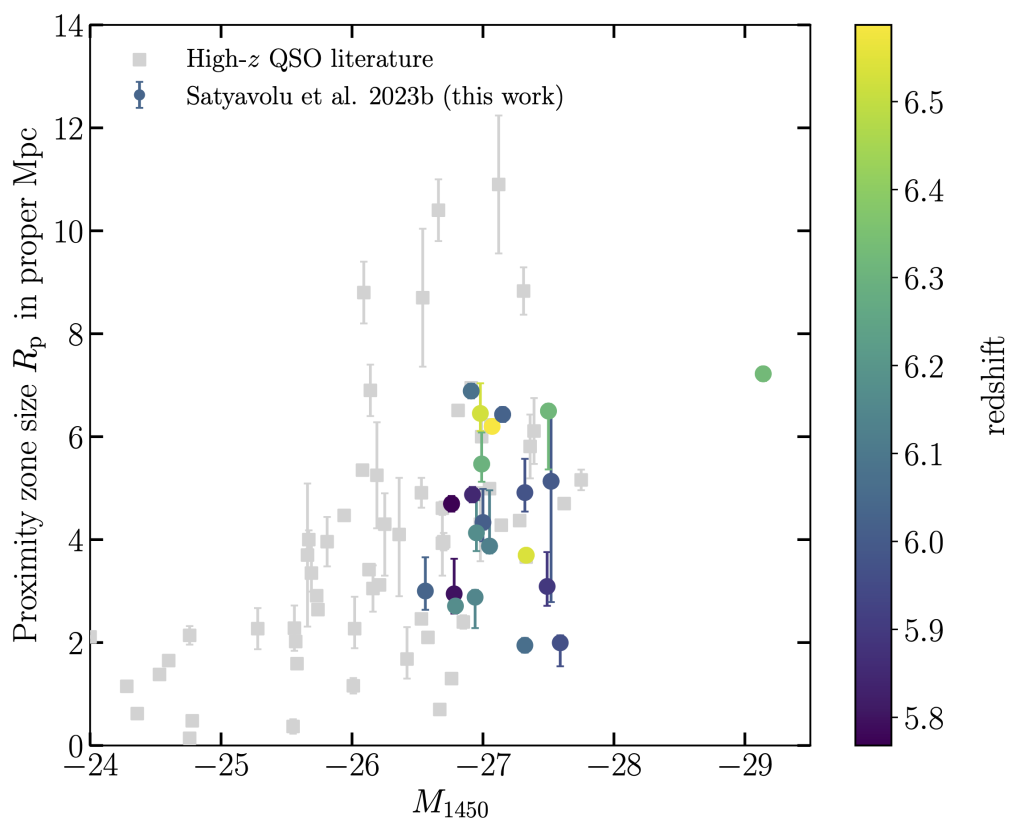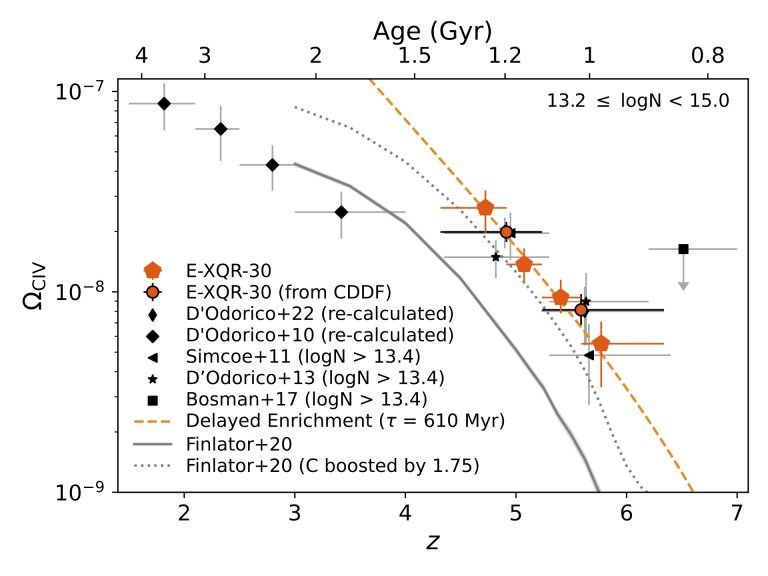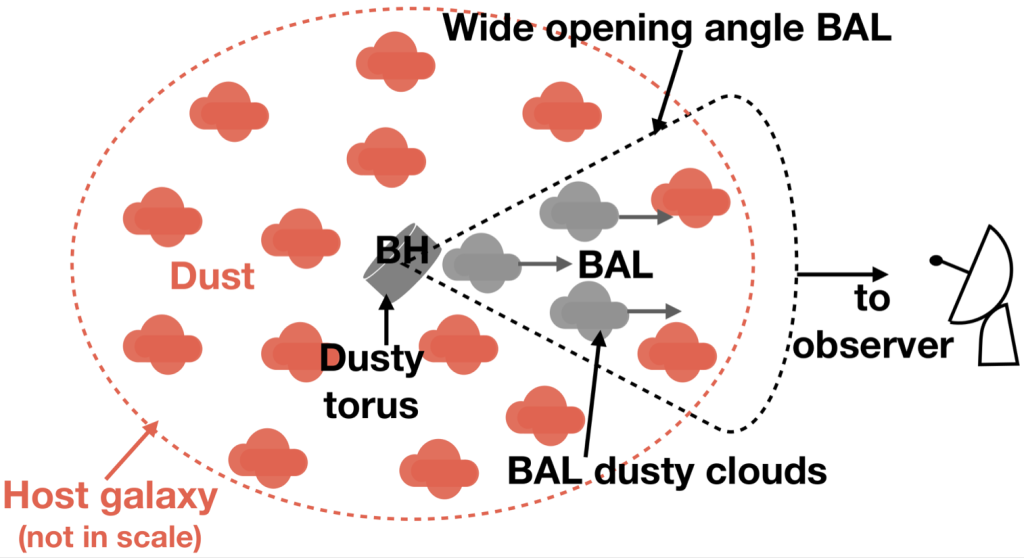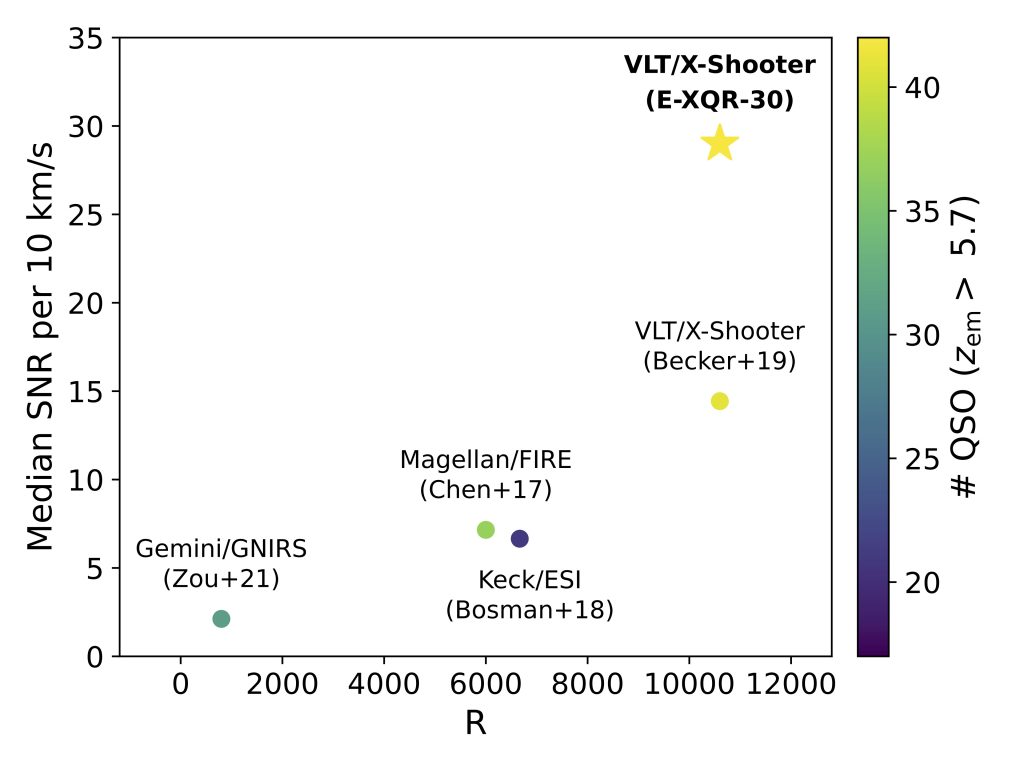News from the collaboration
Comparison of the properties of E-XQR-30 (star) with other spectroscopic surveys of quasars at z ~ 6 in terms of spectral resolution, median SNR and number of targets (color scale in the sidebar). The comparison samples were selected among those published to date being obtained with a given instrument and with available median SNR values. In particular, the sample of XSHOOTER spectra in Becker et al. (2019) is a picture of the situation before the XQR-30 survey. We also note that XSHOOTER is the instrument that offers the broadest, simultaneous wavelength coverage with respect to Magellan/FIRE (0.82-2.51 μ m), Gemini/GNIRS (0.85-2.5 μ m) and Keck/ESI (0.39-1.1 μ m).
March 28, 2023: The paper “New quasar proximity zone size measurements at z ~ 6 using the enlarged XQR-30 sample” has been accepted for publication in MNRAS. This work is led by Sindhu Satyavolu, a PhD student at the Tata Institute of Fundamental Research, India.
The masses of the central black holes of z ~ 6 quasars have been measured to be around 10^9 solar mass. The existence of such supermassive black holes at a time when the universe was less than just a Gyr old remains an unsolved problem.
A key component in understanding the growth of SMBHs is measuring the quasar lifetimes. One of the ways to measure quasar lifetimes at high redshift is measuring the size of their proximity zone, i.e. the region around the quasar where it dominates the radiation field.
In this paper, we present 22 new measurements of quasar proximity zones at redshifts between 5.8 and 6.6, using the enlarged XQR-30 sample. Our inferred proximity zone sizes are 2–7 physical Mpc, with a typical uncertainty of less than 0.5 physical Mpc, which, for the first time, also includes uncertainty in the quasar continuum. We find that the correlation of proximity zone sizes with the quasar UV magnitude, redshift, and the central supermassive black hole mass indicate a large diversity of quasar lifetimes. We also find a strong correlation between proximity zone sizes and the distance to the nearest metal absorber from the quasar.
Two of our quasars have proximity zone sizes that are exceptionally small. The spectrum of one of these quasars, PSOJ158-14, with z=6.02, displays, unusually for this redshift, damping wing absorption without any detectable metal lines, which could potentially originate from the neutral inter-galactic medium. The other quasar, PSOJ108+08, has a high-ionization absorber ~0.5 physical Mpc from the edge of the proximity zone.
This work increases the number of proximity zone measurements available in the last stages of cosmic reionization to 87. This data will lead to better constraints on quasar lifetimes and obscuration fractions at high redshift, which in turn will help probe the seed mass and formation redshift of supermassive black holes.

Proximity zone sizes of quasars from our sample as a function of quasar magnitude and redshift. Also shown in grey are previous measurements at similar redshifts.

April 5, 2022: The paper “Chemical Abundance of z~6 Quasar Broad-Line Regions in the XQR-30 Sample” has been accepted for publication in MNRAS. This work is led by PhD student, Samuel Lai, working with Dr. Fuyan Bian and Dr. Chiara Mazzucchelli of European Southern Observatory, as well as Prof. Christian Wolf and Dr. Christopher Onken at Australian National University.
The brightest quasars at redshift z ~ 6 reflect some of the most massive and fastest growing black holes with likely the largest host galaxies within the first billion years of the universe since the big bang. The chemical abundance (or metallicity) of these earliest galaxies provides clues regarding their rates of star formation, supernovae frequency, and the resulting chemical evolution. In the low-redshift universe, it’s clear that properties of central black holes and host galaxies are closely intertwined. Though this relationship is not yet convincingly established at high redshift, studying metallicity in galactic nuclear material provides a window to probe the chemical properties of the reservoir of gas from which the black hole accretes.
Our study is made possible by the high signal and high resolution observations of the brightest z ~ 6 quasars by the XQR-30 survey. We were able to take advantage of the high quality spectra to measure the structure and properties of broad emission-lines originating from chemical elements at various stages of ionisation within the hot gas surrounding the black hole.
This research investigated emission lines originating from the quasar broad-line region (BLR) in close proximity to the black hole. For this study, we utilised relationships between metallicity and emission-line flux ratios in the rest-frame ultraviolet determined from photoionisation models. We measured average line ratios which are consistent with composites of low redshift quasar spectra from black holes with similar physical properties, but the line ratios are also strongly correlated with the blueshift of the CIV emission line, an indicator of emission from an outflowing component. If this outflowing contribution is not taken into account, it is possible to measure metallicity over 10 times the solar abundance at high redshift, which may indicate exotic chemical enrichment scenarios or enhanced supernova rates. Rather, our results found the metallicity of the BLR to be at least 2-4 times the solar abundance when the contribution of the blueshifted emission is minimised. While still super-solar, this lower metallicity is more readily reproduced in less extreme chemical evolution models in the galactic nuclear region. Overall, these results suggest that the BLRs of these quasars are already rapidly enriched to several times the solar abundance very early on in the universe. After which, there is no appreciable change in the metallicity for black holes with similar properties over vast swathes of cosmic time.
March 9, 2022: XSHOOTER observations of the XQR-30 Large Programme have been completed!
March 3, 2022: Discovery of strong black-hole outflows suppressing black-hole growth in quasars at redshifts 5.8-6.6, based on XQR-30 quasar spectra. Results have been published in Nature (Bischetti M., Feruglio C., D’Odorico V., et al. Suppression of black-hole growth by strong outflows at redshifts 5.8-6.6, 2022, Nature 605, 244–247 (2022). https://doi.org/10.1038/s41586-022-04608-1). This work is led by Postdoc researcher Manuela Bischetti, working at INAF Observatory of Trieste.

September 14, 2021: The first paper based on the XQR-30 quasar spectra has been accepted for publication in the Astrophysical Journal, it is led by a young PhD student, Yongda Zhu, working in the group of Prof. George Becker at the University of California Riverside.

